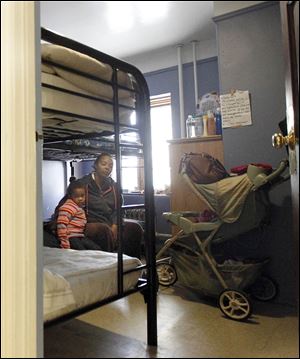
EDITORIALS
Give them shelter
Central access is one of the many practices Toledo must reconsider to serve homeless people better
11/24/2013
In this October photo, Sasha Smith sits with her daughter Makya, 4, in Family House. She said she had trouble getting help through the 211 system.
There are many reasons that Toledo Mayor-elect D. Michael Collins defeated incumbent Mike Bell this month, but the failure of the Bell administration to serve Toledo’s neighborhoods — including the homeless population — is one of the biggest. Fortunately, competent and dedicated local shelters continue to keep homeless people off Toledo’s streets.
On this issue, Mr. Collins should learn from Mayor Bell’s mistakes. He can start by making the city’s Department of Neighborhoods responsive, open, and accountable. Working with shelters, the United Way of Greater Toledo, and homeless people and their advocates, he will also need to re-evaluate how this community serves the homeless and rebuild trust between city government and emergency shelters.
Click here to read more Blade editorials.
Relations have frayed badly under this administration. The Blade reported recently that the city had withheld, since July 1, roughly $8,000 a month in federal aid to Family House, a shelter in central Toledo, over $19 spent on gasoline to transport homeless people to a Mud Hens game. The city finally paid the shelter this month, Renee Palacios, the executive director of Family House, told The Blade’s editorial page.
It’s unclear whether the Department of Neighborhoods sought to punish an outspoken shelter director or was just blinded by red tape. Either way, under Mayor Bell, the department has become an unresponsive bureaucracy that at times appears almost at war with the shelters.
Cuts in funding from the U.S. Department of Housing and Urban Development demand efficient delivery of services. That’s impossible if all those who are charged with helping Toledo’s homeless population are not working together.
So-called centralized intake has become one of the most divisive issues. Before this year, Toledo had a “no wrong door” policy. Homeless people would go to a shelter and either find help there or get sent to another shelter.
Since early this year, however, people who seek shelter must call the United Way’s 211 line. They answer certain questions, then get referred by an operator to a shelter that has room. One shelter even installed a phone near its entrance so that staff members could help homeless people with 211 calls.
Once in an emergency shelter, clients are supposed to meet quickly with United Way housing specialists — funded by the Toledo-Lucas County Homelessness Board — who assess their needs and try to place them in permanent housing. United Way gets $193,000 a year to provide these so-called coordinated assessment services. (The agency gets no additional money for its 211 line.)
United Way’s 211 system has advantages, including up-to-date and thorough information about shelter availability in Toledo, round the clock. At the United Way call center in downtown Toledo, the conversations of call operators are monitored for thoroughness, accuracy, initiative, and even empathy.
But some calls were mishandled, especially after hours and on weekends, when they were taken by out-of-county operators in Napoleon, 40 miles away. Outsourcing those calls was a mistake. Local operators now handle all calls.
The best option may be to use both 211 and “no wrong door,” as Ken Leslie, a local homeless advocate and founder of Tent City, recommends. While keeping the advantages of 211 central access, shelters could also immediately serve people at their doors who may be cold, hungry, or mentally ill.
The two systems could complement each other, as long as both recorded and reported all emergency shelter placements, so that the community’s data bank of shelter beds remained current.
Continuing to use United Way case managers and housing specialists to move people from emergency shelter to permanent housing may also be the best option. United Way is adding a case manager for coordinated assessment, and backlogs have reportedly ended.
Wait times in emergency shelters to see a housing specialist don’t exceed a week, and often are less than 72 hours. Coordinated assessment has lowered the number of people returning to homelessness.
Still, the Bell administration and its successor, and the community, should determine how the system could improve. Would United Way case workers, for example, be more effective if they were based in assigned shelters?
Among the other issues the community must examine, perhaps through a task force, is developing more flexible local guidelines for rapid rehousing — the practice of moving people out of shelters quickly. Rapid rehousing doesn’t work for everyone, including some victims of domestic abuse. Homeless people, and former homeless people, must be part of this larger community conversation.
Roughly 1,000 people are homeless in Toledo at any given time, but as many as 3,000 are homeless at some time during the year. So far, Toledo has made sure they don’t end up under bridges, in parks, or inside vacant buildings.
Much of that progress was threatened during the Bell administration. Maintaining it, and moving forward, will take a lot more openness, good will, and cooperation from Mayor Collins’ team.